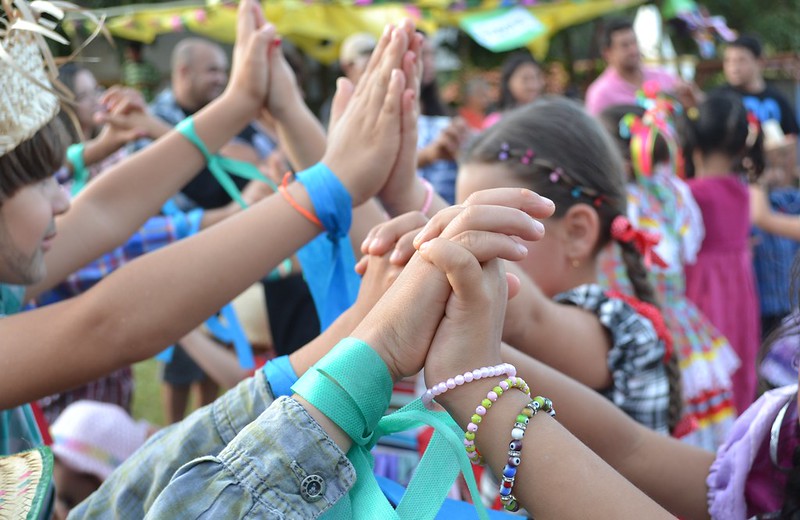Festa Junina
Brazil’s Winter Carnival of Fire, Flavor, and Folklore
2026/05/31 - 2026/06/29
Every June, towns and cities across Brazil are filled with color, music, and rustic joy as the exuberant Festa Junina takes over. For a whole month, church squares, schoolyards, and city plazas are decorated with lanterns, flags, and straw hats. Millions gather to dance the quadrilha (folk dance), savor corn-based sweets, and warm themselves around bonfires under the stars. Even in the city, this festival brings the warmth and spirit of the countryside, inviting locals and travelers alike to join in the fun with a smile.
Festa Junina is celebrated nationwide, but the largest festivities are in the Northeast, especially in Campina Grande and Caruaru. These cities compete for the title of “World’s Biggest São João,” drawing families, food lovers, music fans, and tradition enthusiasts. The laughter and crackling of bonfires fill the air, creating a heartwarming community celebration.
Main Attractions
Quadrilha and the Mock Wedding
The highlight of Festa Junina is the quadrilha, a lively folk dance with roots in European country dances. Couples dress as brides and grooms, performing comic skits, playful chases, and calling out “Anarriê!” and “Olha a chuva!” Accordion, triangle, and zabumba drums fill the square, while dancers in plaid shirts, patchwork dresses, and straw hats laugh and twirl under the night sky.
Bonfires and Fireworks
Bonfires are lit everywhere, their warmth and the scent of burning wood filling the night. Children and adults gather to roast corn, set off colorful fireworks, and jump over the flames for good luck. The crackle of fire, the smoke, and the scent of gunpowder create a magical, rustic atmosphere.
Key Events
In big cities, you’ll find live forró music, accordion duels, and dance competitions. Costume contests, pau de sebo (greased pole climbing), sack races, and bingo are traditional games that add to the fun. Children perform quadrilha dances, and food stalls offer local specialties. The climax is the “Night of São João” on June 23, when the biggest bonfires and parties take place.
Costumes and Decorations
Participants dress in “caipira” (country) style: men wear patched pants, plaid shirts, and painted freckles; women wear colorful ruffled dresses, braids, and straw hats. Venues are decorated with paper lanterns, colorful flags (bandeirinhas), and makeshift barns. The feel of straw, the rustle of skirts, and the warmth of the fire bring the countryside to the city.
Traditional Food & Drink
Festa Junina is also a food festival. Grilled corn, canjica (sweet corn pudding), pamonha (steamed corn cakes), pé-de-moleque (peanut brittle), and quentão (spiced hot cachaça or mulled wine) are everywhere. Bolo de milho (corn cake), cocada (coconut candy), and hot mulled wine are also favorites. Sweet, smoky, creamy, and crunchy—each bite is a taste of rural Brazil.
Cultural and Historical Background
Festa Junina originated in 16th-century Portugal. At that time, midsummer festivals were held across Europe to celebrate the solstice, the harvest, and to give thanks for nature’s bounty. Portuguese settlers brought these traditions to Brazil, where Festa Junina blended with Indigenous and African customs and evolved into something uniquely Brazilian. In the Northeast, the festival coincides with the dry season harvest, and farmers give thanks to patron saints like Saint John (São João), Saint Peter, and Saint Anthony.
The bonfire, a symbol of the festival, was originally meant to ward off evil spirits and to pray for a good harvest and family health. Quadrilha dances, mock weddings, and traditional foods all reflect a mix of European, African, and Indigenous influences. Over time, Festa Junina became an expression of rural life, faith, and community solidarity.
Today, the festival is celebrated on a grand scale in cities as well, strengthening family and community bonds across generations, regions, and social backgrounds. In the Northeast, it’s a symbol of local identity and pride, drawing millions of participants every year.
Participant Voices
I joined Festa Junina in Salvador as a tourist. When I jumped into the quadrilha, everyone cheered me on—even though I didn’t know the steps! My first taste of quentão was sweet, spicy, and unforgettable!
Fun Facts
- Campina Grande and Caruaru both claim to host the “World’s Biggest São João,” each drawing over 2 million visitors annually.
- Traditional foods like canjica and pamonha are made mainly from corn, symbolizing the harvest’s bounty.
- Festa Junina is also called “Brazil’s Winter Carnival.”
Festival Dates
Festa Junina is celebrated nationwide throughout June, with the largest events in the Northeast.
The event schedule is subject to change. Please check the official website for the most up-to-date information.
Information
| Name | Festa Junina |
| Country | Brazil |
| Area | |
| Date | 2026/05/31 - 2026/06/29 |
| Link |
Upcoming Festivals
Dia de la Virgen de Guadalupe Mexico
A Festival Weaving Faith, Fervor, and Mexican Identity
2025/12/11L'Escalade Switzerland
Geneva’s Grand Winter Festival of Courage, Chocolate, and Community
2025/12/12Umkhosi Wokweshwama South Africa
The Zulu First Fruits Festival—A Sacred Celebration of Land, Ancestors, and Renewal
2025/12/12Lucia Festival (St. Lucia's Day) Sweden
A Festival of Light Illuminating the Nordic Darkness
2025/12/15Las Posadas Mexico
The Luminous Quest for Sacred Shelter
2025/12/22Noche de Rabanos (Night of the Radishes) Mexico
A celebration blending art, farming heritage, and cultural traditions
2025/12/23Chant of the Sybil on Majorca Spain
A Medieval Prophecy Echoes Through Majorcan Christmas
2025/12/23‘Hatajo de Negritos’ and the ‘Hatajo de Pallitas’ Peru
A Christmas Festival of Rhythm, Faith, and Afro-Andean Heritage in Peru’s Ica Region
2025/12/24Harbin International Ice and Snow Sculpture Festival China
A Frozen Wonderland Where Art and Adventure Merge
2025/12/24Takanakuy Peru
The Andean Festival of Reconciliation by Fist—How Confrontation Creates Year-End Peace and Bonds


